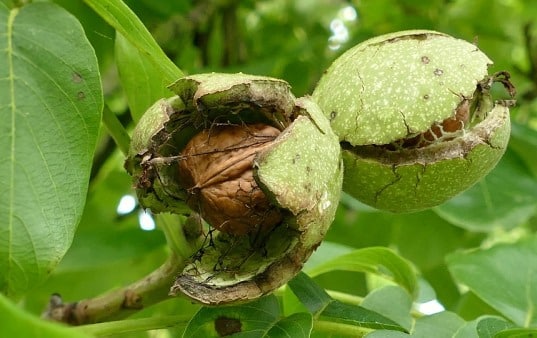Walnut cultivation, or 'Akhrot' farming in India, is gradually becoming popular, particularly in hilly areas. India has a favourable climate for walnut cultivation, but mainly in northwestern India. The crop is ideally suited for commercial cultivation in areas with good soil and cool weather.
In this guide, you will learn about the complete farming procedure for cultivation.
Complete Process of Growing Walnuts in India
Walnut farming involves several important steps, from land preparation to harvesting. Each stage plays a big role in getting a healthy and high-yielding crop.
Land Preparation
Prior to planting the trees, prepare the land well. On level ground, plant trees in a square manner with roughly twelve meters between them. On slopes, use contour planting to prevent erosion of the soil. Land preparation enables trees to receive sunlight, air, and nutrients necessary for proper growth and increased yield.
Working with a tractor such as the Powertrac 439 price simplifies land preparation and saves time. It comes with a 41 HP engine having 38.9 PTO HP power, which is sufficient for heavy field activities. Its durability and fuel economy enables extended working hours with fewer fuel expenses, benefitting farmers by saving them money.
Propagation Methods
You can grow walnuts from seeds, grafting, or budding. Trees grown from seeds take 10 to 12 years to produce nuts. Grafted trees start fruiting earlier, usually in 4 to 5 years. In commercial farms, trees give good nut production in 6 to 8 years. Also, using local seedlings as rootstock helps improve growth and protect against diseases.
Seed or Plant Selection
In India, farmers mostly grow the Persian walnut, known for its good nuts. This dry fruit comes in four types based on shell thickness: hard, medium, thin, and paper-shelled. The paper-shelled type is easy to open and popular in markets. Jammu and Kashmir is the major producer, followed by Himachal Pradesh, Uttarakhand, and Northeast areas like Arunachal Pradesh.
Planting
Clear the land properly before sowing. To begin with, clear all weeds and previous roots from the ground. The land is ploughed three or four times until the land gets soft and fine. A well-prepared land facilitates roots to spread effortlessly and become strong.
Irrigation and Watering
Water is an important part of farming, particularly when the trees are young. Begin watering right after planting and continue doing so regularly, depending on the weather. Don't give the trees too much water, as this may damage the roots and hinder tree growth.
Additionally, most farmers apply flood, furrow, border strip, sprinkler, or drip systems. Drip and sprinkler irrigation perform better since they conserve water and deliver it directly to the roots. This aids trees in growing well and providing quality nuts.
Fertilizer and Nutrient Management
Trees require proper nutrients to grow healthy. Compost or cow dung should be added to the soil before planting. This improves the soil and provides natural fertilizer to the trees. It makes the roots strong and healthy.
After seeding, apply fertilizers such as nitrogen, phosphorus, and potassium in the proper quantity. Nitrogen facilitates leaf growth, while phosphorus and potassium provide healthy roots and improved nuts. You may also spray zinc or magnesium if necessary.
Weed, Pest, and Disease Control
Weeds take the water and nutrients from the soil, which delays growth. It is vital to maintain a clean field, particularly in the initial years. So, try to eliminate weeds on a regular basis. In certain situations, use herbicides cautiously, only on the advice of experts.
Pests such as aphids, beetles, and caterpillars can damage the trees. Control them using neem oil or light insecticides. Besides, root rot or walnut blight diseases may also occur. You can prevent the trees using clean planting material and safe fungicides.
Harvesting Process and Time
Walnuts typically take 10 to 12 years when propagated from seed and less time when grafted. The nuts are ready for harvesting when the green external husk is about to split open, normally from September to October. It must be done with care so as not to damage it.
Post-Harvest Handling
After being harvested, walnuts are handled well to maintain their quality and value. The nuts are first dried to reduce moisture, which avoids mould and rot. Sun drying or mechanical dryers are normally employed for drying. Then, they are cleaned, graded, and stored in dry and cool places for freshness.
Farmers mostly use tractors such as the Mahindra 265 to move the harvested walnuts at a quicker pace from the fields to storage. It features a 1200 kg lifting capacity, which reduces post-harvesting effort and time.
Final Words
In the end, walnut cultivation in India is a profitable and long-term option for hilly and cool areas. It demands patience and nurturing in the early years, but after trees start producing nuts, they are a reliable means of generating income. If there is proper irrigation, sound plantations, and proper maintenance, walnut cultivation allows rural families to earn better. As demand grows, it is a safe bet for commercial cultivation as well.




.jpg)

Comments